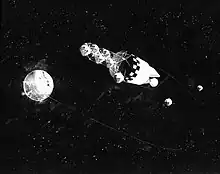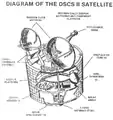
The Defense Satellite Communications System (DSCS)[1] is a United States Space Force satellite constellation that provides the United States with military communications to support globally distributed military users. Beginning in 2007, DSCS began being replaced by the Wideband Global SATCOM system. A total of 14 DSCS-III satellites were launched between the early 1980s and 2003. Two satellites were launched aboard the Space Shuttle Atlantis in 1985 during the STS-51-J flight. As of 14 September 2021, six DSCS-III satellites were still operational.[2] DSCS operations are currently run by the 4th Space Operations Squadron out of Schriever Space Force Base.
Background
DSCS went through three major phases — IDCSP (Interim Defense Communication Satellite Program), DSCS-II, and DSCS-III. Since the first launch, DSCS has been the "workhorse" of military satellite communications. All DSCS III satellites have exceeded their 10-year design life. The National Science Foundation use the DSCS satellites to provide additional bandwidth to Amundsen–Scott South Pole Station and McMurdo Station on Ross Island on the continent of Antarctica.[3]
IDCSP

In April 1960, the Advanced Research Projects Agency (ARPA) initiated the Advent program, aiming to deliver a military communication satellite. However, the design concept surpassed the technological capabilities of the time, leading to the cancellation of the program in May 1962. The Initial Defense Communications Satellite Program (IDCSP) was proposed as one of two recommended follow-up approaches to deliver a working satellite.
Philco (now Ford Aerospace) was contracted for the work. The IDCSP delivered a simple, spin-stabilized satellite placed into a sub-synchronous orbit that did not require station-keeping or active altitude control. The capacity was approximately 1 Mbit/s digital data.
The first launch, comprising 7 satellites, took place in June 1966. The system was declared operational with the 1968 launch and renamed to Initial Defense Satellite Communication System (IDSCS).[4]
A total of 34 IDSCS satellites were built, with 8 lost in a launch failure in August 1966.[5]
DSCS II
DSCS II, developed under Program 777[6] provided secure voice and data transmission for the United States Armed Forces. The program was managed by the Defense Communications Agency (DCA), now the Defense Information Systems Agency.
The space vehicles were spin stabilized with a de-spun antenna platform. The body was mounted with solar cells, which produced 535 watts. Three NiCd batteries provided electrical power and it was supported by a hydrazine propulsion subsystem.
The communications payload included two 20-watt X band channels. The transponders were supported by steerable narrow beam antennas and drive mechanism for communications privacy.
The first DSCS II launch was in 1971.[7]
DSCS III
On 12 December 1975, research and development contracts were awarded to General Electric and Hughes Aircraft Company[8] to begin DSCS III design studies, with the first Block 1 launch on 30 October 1982.[4]
DSCS III satellites support globally distributed Department of Defense (DoD) and national security users. The final 4 of 14 satellites received Service Life Enhancement Program (SLEP) modifications. These changes provided substantial capacity improvements through higher power amplifiers, more sensitive receivers, and additional antenna connectivity options. The DSCS communications payload includes six independent Super High Frequency (SHF) transponder channels that cover a 500 MHz bandwidth. Three receive and five transmit antennas provide selectable options for Earth coverage, area coverage and/or spot beam coverage. A special purpose single-channel transponder is also on board.[9]
DSCS III Spacecraft
| Spacecraft Name | Other Designation | Launch date/time (UTC) | NSSDCA/COSPAR ID | Rocket | Status/Remarks |
|---|---|---|---|---|---|
| DSCS III-01 | DSCS III-A1 | 1982-10-30, 04:05:00 | 1982-106B | Titan 34D | Decommissioned/Launched with DSCS II-16 |
| USA-11 | DSCS III-B4 | 1985-10-03, 15:15:30 | 1985-092B | Space Shuttle Atlantis | Decommissioned[10] |
| USA-12 | DSCS III-B5 | 1985-10-03, 15:15:30 | 1985-092C | Space Shuttle Atlantis | Decommissioned[10] |
| USA-43 | DSCS III-06 or DSCS III-A2 | 1989-09-04, 05:54:00 | 1989-069A | Titan 34D | Decommissioned[10] |
| USA-44 | DSCS III-07 | 1989-09-04, 05:54:00 | 1989-069B | Titan 34D | |
| USA-78 | DSCS III-08 | 1992-02-10, 00:41:00 | 1992-006A | Atlas II | Decommissioned[10] |
| USA-82 | DSCS III-09 | 1992-07-02, 21:54:00 | 1992-037A | Atlas II | Decommissioned[10] |
| USA-93 | DSCS III-10 | 1993-07-19, 22:04:00 | 1993-046A | Atlas II | Decommissioned[10] |
| USA-97 | DSCS III-11 | 1993-11-28, 23:40:00 | 1993-074A | Atlas II | |
| USA-113 | DSCS III-B7 | 1995-07-31, 23:30:00 | 1995-038A | Atlas IIA | Decommissioned on 9 December 2022.[11] |
| USA-134 | DSCS III-B13 | 1997-10-25, 00:46:00 | 1997-065A | Atlas IIA | Operational[10] |
| USA-148 | DSCS III-B11 | 2000-01-25, 01:03:00 UTC | 2000-001A | Atlas IIA | Operational[10] |
| USA-167 | DSCS III-A3 | 2003-03-11, 00:59:00 UTC | 2003-008A | Delta IV | Operational[10] |
| USA-170 | DSCS III-B6 | 2003-08-29, 23:13:00 UTC | 2003-040A | Delta IV | Operational[10] |
Image gallery
 DSCS-2 diagram
DSCS-2 diagram DSCS-3 diagram
DSCS-3 diagram
See also
References
- ↑ Burroughs, William E. (1986). Deep Black. New York: Berkley Publishing Group. pp. 187. ISBN 0-425-10879-1.
- ↑ "DSCS III Constellation". Air Force Fact Sheet. Archived from the original on 27 April 2017. Retrieved 26 April 2017.
- ↑ "DSCS III use for Antarctica". Amundsen-Scott South Pole Station. Archived from the original on 27 April 2017. Retrieved 26 April 2017.
- 1 2 Martin, Donald H. (1986). Communication Satellites 1958-1988. El Segundo: Aerospace Corp. p. 285.
- ↑ McDowell, Jonathan. "Satellite Catalog". Jonathon's Space Report. Retrieved 27 April 2021.
- ↑ Martin, Donald H. (2000). Communication Satellites. AIAA. ISBN 9781884989094.
- ↑ "DSCS II". Encyclopedia Astronautica. Archived from the original on 26 June 2017. Retrieved 27 April 2017.
- ↑ Fiscal year 1977 authorization for military procurement, pt. 6, p. 3769.
- ↑ "DSCS III". Air Force Fact Sheet. Archived from the original on 27 April 2017. Retrieved 26 April 2017.
- 1 2 3 4 5 6 7 8 9 10 "Defense Satellite Communications System". United States Air Force. November 2015. Retrieved 7 January 2023.
- ↑ Gibson, Hillary (14 December 2022). "SpOC officially retires DSCS satellite". Space Operations Command. United States Space Force. Retrieved 2 January 2023.
External links
- Lockheed Martin's Page on DSCS
- Federation of American Scientists - DSCS 3
- U.S. Air Force MILSATCOM - DSCS
- NASA JPL - DSCS
- Air Force - DSCS III
- NASA's National Space Science Data Center (NSSDC) - Master Catalog - Spacecraft Query
6
